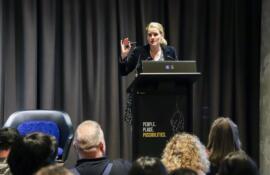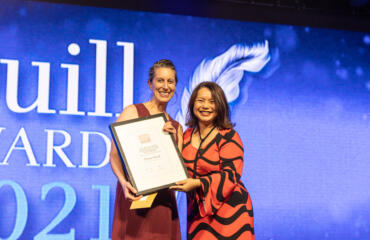‘A concern for Australian wildlife has always been a part of me. My grandfather had a stack of old magazines about native animals describing which were under threat and how to save them. As a young girl I remember reading these and having a strong desire to help.
Squirrel gliders have been part of my life for close to a decade. It started with my honours project where I studied genetic connectivity of the species, which is listed as threatened in Victoria. After this, I worked as a research assistant on a project that built crossing structures for squirrel gliders in five locations on the Hume Highway.
‘A surprising thing I found is there’s no difference in survival rates between gliders that live close to the highway and those that live far away.’
My PhD was a continuation of the crossing structure project. My aim was to find out if the bridges made a positive difference to squirrel glider populations.
Close to $150,000 was spent on building five pretty crazy looking things over the Hume Highway. I had to gauge if it was worthwhile, and if it’s something we should do more of in the future.
The crossings are horizontal rope ladders that bridge the gap between trees on either side of the highway. Existing research showed gliders could not cross a gap wider than 50 metres (squirrel gliders glide between 30 and 40 metres).
I compared the squirrel glider’s genetic make-up, survival rates and movement before and after installation of the bridges. I related populations near the highway to those far away. I also compared non-bridge populations to bridge populations along the highway.

A surprising thing I found is there’s no difference in survival rates between gliders that live close to the highway and those that live far away.
Instead of risking their lives attempting to cross a busy road, the little marsupials will isolate themselves to one side. This lack of movement means gliders are breeding in a small gene pool and this can be a big problem for genetic diversity.
Genetic diversity allows animals to evolve and adapt to changing environments and keeps them resilient. When a population loses diversity, they lose fitness and they can’t breed as well as they used to.
Before the rope bridges, gliders on opposite sides of the road were genetically different which proved the roads were blocking the animals either side from mating.
After the bridge installations, the animals living on opposite sides of the roads tested as one genetic population (instead of two, separated by a highway).
One of the reasons I’m attracted to this research is because of its location. I grew up in Benalla, a small town close to where the crossing structures were built. Every time I drive home, I feel emotional about the landscape, especially the tall eucalyptus trees fringing the highway, which is where the gliders live.

I’m a conservation biologist and the reason we do our work is to make a difference in the real world. Being able to test the crossing structures near my hometown was very important to me.
The most memorable moment of my Phd was seeing footage of a squirrel glider using a bridge for the first time. It had been 18 months of nothing. Or sometimes, in what was a cruel tease – a spider or a bird would trigger the cameras.
But one morning I checked the footage and I saw a squirrel glider using the bridge. I will never forget what that felt like.
From then on gliders used the structures more frequently and soon I had four or five crossing every night.
It was a long time before I could show the project was working. There were many sceptics.
When I went home to Benalla, people would say things to me like: “Those stupid looking things will never work” or “I’ve never seen anything up there”.
When you can show someone a photo of a squirrel glider, or any other threatened species using the bridge, it is the single most powerful tool to advocate for the project.
To date, more than 2000 squirrel gliders have used the bridges. Six species have crossed in total, including sugar gliders, common brush tail possums, common ringtail possums, brush-tailed phascogales and one goanna.
‘My research shows crossing structures work – not just on new roads but on roads already built.’
When a major road project is built and there is an impact on a threatened species, most governments will have to take some form of protective action. This may be developing a habitat offset or building a crossing structure. My research shows crossing structures work – not just on new roads but on roads already built. My life with the squirrel glider is not over yet. I’ve accepted a position of Postdoctoral Fellow with the Australian Research Centre for Urban Ecology. I will continue my work on crossing structures and conservation of squirrel gliders for future generations.’Kylie Soanes’ thesis is titled: “Evaluating the success of road-crossing mitigation for arboreal mammals: How does monitoring effort influence the detection of population-level effects?”
* My PhD is an irregular series in which The Citizen speaks with recent Melbourne University PhD graduates.


